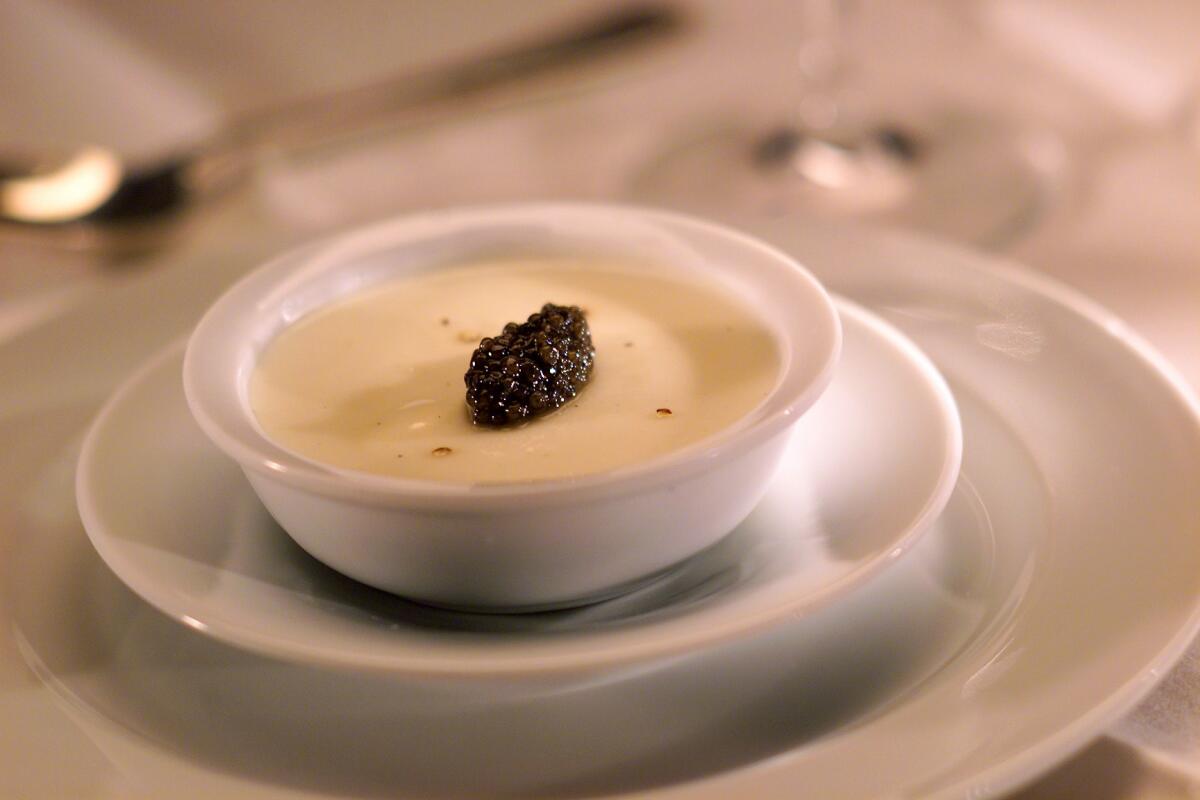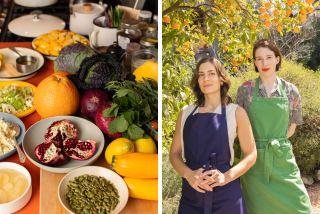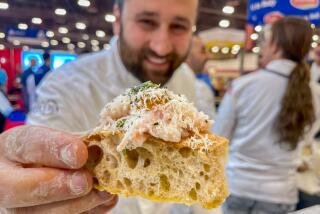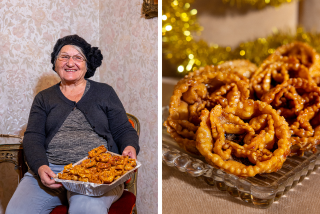From the Archives: Pudding gets a rewrite

What inspires new dishes? Not just new ingredients, unusual food pairings or advanced equipment. They’re more likely to arise from rethinking old, sometimes even pedestrian, dishes. Panna cotta , a traditional Italian dessert of cooked cream, is a perfect example of a familiar dish that can be reborn.
Perhaps the simplest of all the custard-like desserts, panna cotta is made by sweetening cream, cooking it and then setting it with gelatin. Variations on the theme abound (such as the now-ubiquitous--and in the right hands, wonderful--buttermilk panna cotta) . But take away the sugar and the dessert label, reduce it to its fundamental principle--gelled cream--and panna cotta blossoms into countless new versions.
It’s really quite simple: Add a vegetable to the cream you’re cooking--cauliflower, for instance--puree and strain it, add gelatin and let it set. This is an excellent panna cotta because the vegetable’s delicate flavors are heightened by the cream. A salty, elegant garnish of caviar makes it a simple but extraordinary canape.
The pleasures of such a dish are the new form you give to the vegetable and the great delicacy of texture, which results from the high fat content of cream and a judicious use of gelatin. Begin with a basic ratio of gelatin to liquid--half of a 1/4-ounce envelope of gelatin to 11/2 cups of puree--but experiment to find what gives you the finest texture.
Many professional pastry chefs prefer sheet gelatin to the more commonly available granulated gelatin. If you can find it (check stores that sell cake-decorating equipment), four sheets equal one (1/4-ounce) package of granulated. Whichever you use, panna cotta should have a distinct body to it but should offer no resistance on the palate. It should almost give the sense of melting on your tongue.
The variations on panna cotta are limited only by your imagination. Potatoes make a beautiful panna cotta , which might be served with sliced chestnuts for a great fall or winter dish. In the spring, onions would work too, and in the summer, corn or sweet bell peppers will be exciting.
And if these vegetables translate well, why not others? First consider the kind of vegetable. Cook green vegetables for a panna cotta as if you were going to serve them whole--that is, blanched in a big pot of heavily salted water and shocked in ice water. Then puree them. For green vegetable panna cottas , furthermore, you don’t need to cook the cream--just heat it enough to melt the gelatin. Pea panna cotta would be great garnished with smoked salmon; you could also make fava bean panna cotta and garnish it with ham or prosciutto.
One of the advantages of panna cottas is that they set up in the dishes they’ll be served in. That means that, unlike custards, you don’t need to unmold them.
It also means you’re able to have a slightly more delicate texture. It can’t be too loose, though. Part of the delight is that you are serving something that is flavorful and creamy but that has a distinct body to it.
But the most satisfying part for the cook is finding an old technique and, without changing its basic premise, making it something completely new.
Keller is chef at the French Laundry in the Napa Valley. He and Ruhlman are co-authors of “The French Laundry Cookbook” (Artisan, $50). Previous columns by them can be found on The Times’ Web site, at www.latimes.com/keller.
Cauliflower “Panna Cotta” With Beluga Caviar
Active Work Time: 15 minutes * Total Preparation Time: 3 hours plus 3 hours chilling
We were trying for a single soup and the failure resulted in two terrific canapes. We’d hoped to make a cold lobster cauliflower soup--cauliflower puree on the bottom with a clear mirror of lobster consomme on top finished with caviar--but the cream in the cauliflower puree clouded the consomme. So now we serve the cauliflower as a “panna cotta” with oyster jelly and Beluga, and we serve the lobster jelly as a consomme by itself.
3 oysters or 1/4 cup oyster juice
1/2 pound cauliflower, cut in large florets, stems trimmed
2 tablespoons butter
1 cup whipping cream
Coarse salt
1 1/2 teaspoons unflavored gelatin, divided
Freshly ground pepper
1 to 2 ounces Beluga caviar
Oyster juice is used for the layer of jelly covering the “panna cotta.” To make it, shuck the oysters and carefully reserve any juices from them. Strain the juice through a fine mesh strainer into a small bowl and add the oysters. Pour 1/4 cup of water over the oysters and refrigerate them, covered, for several hours or overnight.
Cut the florets of cauliflower vertically through the stems into 1/2-inch slices. Spread the cauliflower evenly in a 3 1/2-quart saucepan and add the butter and 1 1/2 cups of water or enough water to come just to the top of the vegetables (they should not be submerged). Simmer over medium heat until the liquid is reduced by about half and the vegetables are fairly tender, 20 to 25 minutes. Add the cream and simmer to reduce the cream and completely cook the cauliflower, another 30 minutes. The contents of the saucepan should measure 2 cups.
Blend the cauliflower and cooking liquid in a food processor until completely smooth. Strain through a fine mesh strainer or a chinois. There should be about 1 1/2 cups of the puree. Add salt to taste.
Sprinkle 1 teaspoon of gelatin over 1 tablespoon of cold water; stir and let soften, 1 to 2 minutes. Warm half the cauliflower puree over medium-low heat until it barely simmers. Stir in the softened gelatin until dissolved, about 2 minutes. Stir in the remaining puree.
Spoon about 2 tablespoons of the “panna cotta” into the bottom of each small serving bowl and refrigerate for at least an hour to set. This can be done several hours ahead.
Remove the oysters (discard them) and strain the juice. You will need 1/4 cup of oyster juice. Place the remaining 1/2 teaspoon of gelatin and 2 teaspoons of water in a small metal bowl set over a pan of hot water. Stir constantly to dissolve the gelatin. Remove the bowl from the heat and add the oyster juice. Stir again to be sure that the gelatin and juice are completely combined. Add about 3 grinds of pepper. Place the jelly in the refrigerator and stir occasionally until it has thickened to the viscosity of salad oil and the bits of pepper are suspended in the liquid, about 1 hour.
Coat the tops of the chilled “panna cotta” with 1 teaspoon of the jelly, rotating the bowls to ensure an even coating. Return to the refrigerator to set, 30 minutes.
Before serving, garnish the top of each “panna cotta” with a “quenelle” of caviar: Lightly drag the edge of a teaspoon across the caviar, collecting it in a smooth shape resembling a football. This may take some practice to get right. If it’s too much trouble, no one will complain about a simple 1-teaspoon mound of caviar.
12 servings. Each serving: 80 calories; 111 mg sodium; 52 mg cholesterol; 7 grams fat; 4 grams saturated fat; 3 grams carbohydrates; 3 grams protein; 0.46 gram fiber.
More to Read
Eat your way across L.A.
Get our weekly Tasting Notes newsletter for reviews, news and more.
You may occasionally receive promotional content from the Los Angeles Times.









